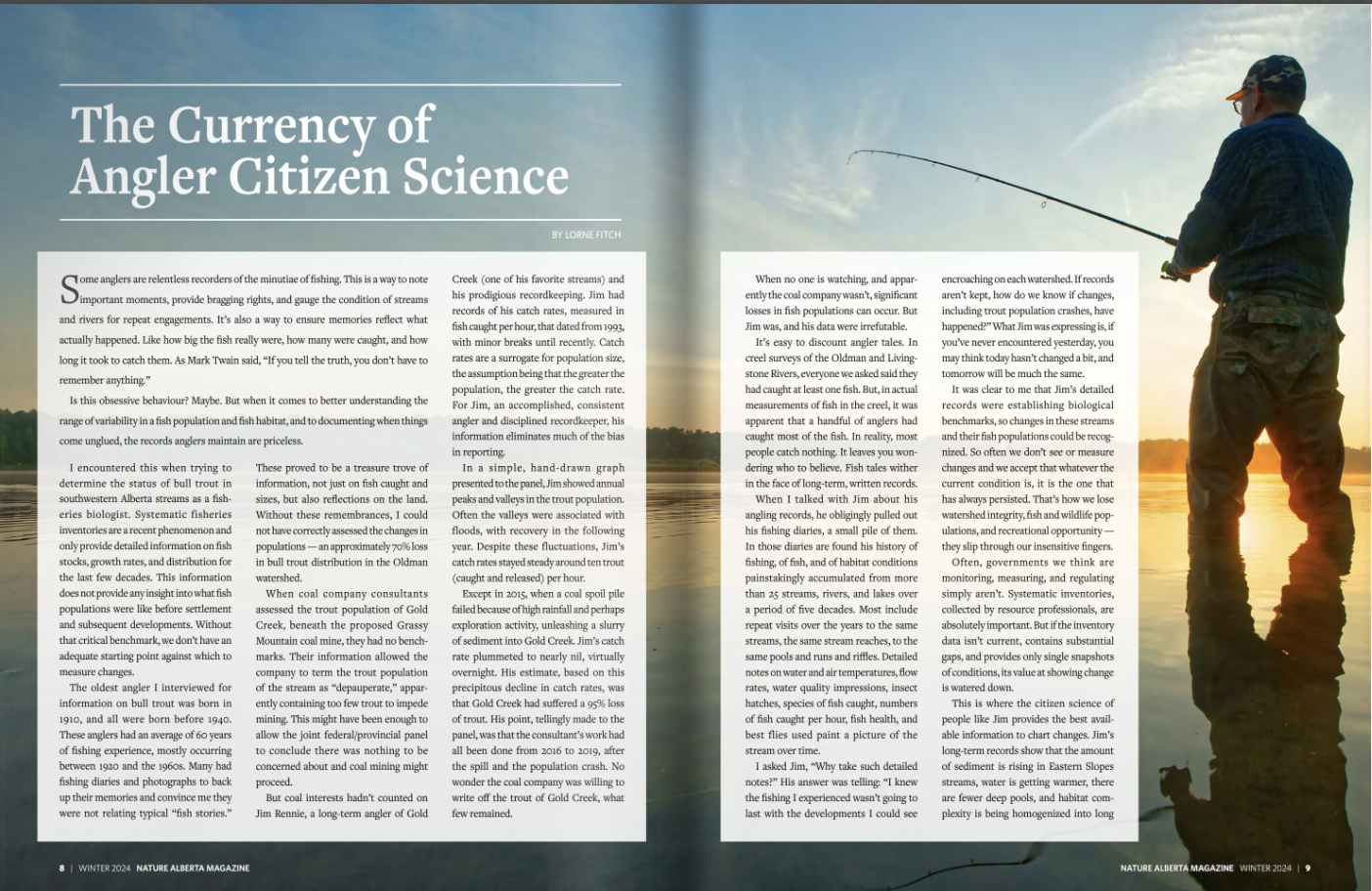The Currency of Angler Citizen Science
19 January 2024

BY LORNE FITCH
Some anglers are relentless recorders of the minutiae of fishing. This is a way to note important moments, provide bragging rights, and gauge the condition of streams and rivers for repeat engagements. It’s also a way to ensure memories reflect what actually happened. Like how big the fish really were, how many were caught, and how long it took to catch them. As Mark Twain said, “If you tell the truth, you don’t have to remember anything.”
Is this obsessive behaviour? Maybe. But when it comes to better understanding the range of variability in a fish population and fish habitat, and to documenting when things come unglued, the records anglers maintain are priceless.
I encountered this when trying to determine the status of bull trout in southwestern Alberta streams as a fisheries biologist. Systematic fisheries inventories are a recent phenomenon and only provide detailed information on fish stocks, growth rates, and distribution for the last few decades. This information does not provide any insight into what fish populations were like before settlement and subsequent developments. Without that critical benchmark, we don’t have an adequate starting point against which to measure changes.
The oldest angler I interviewed for information on bull trout was born in 1910, and all were born before 1940. These anglers had an average of 60 years of fishing experiences, mostly occurring between 1920 and the 1960s. Many had fishing diaries and photographs to back up their memories and convince me they were not relating typical “fish stories.” These proved to be a treasure trove of information, not just on fish caught and sizes, but also reflections on the land. Without these remembrances, I could not have correctly assessed the changes in populations — an approximately 70% loss in bull trout distribution in the Oldman watershed.
Another example of how angler diaries have benefited fish management involves the proposed Grassy Mountain coal mine. When coal company consultants assessed the trout population of Gold Creek, beneath the proposed mine, they had no benchmarks. Their information allowed the company to term the trout population of the stream as “depauperate,” apparently containing too few trout to impede mining. This might have been enough to allow the joint federal/provincial panel to conclude there was nothing to be concerned about and coal mining might proceed.
But coal interests hadn’t counted on Jim Rennie, a long-term angler of Gold Creek (one of his favorite streams) and his prodigious recordkeeping. Although bull trout have long been lost from this creek, westslope cuthroat trout have hung on. Jim had records of his trout catch rates, measured in fish caught per hour, that dated from 1993, with minor breaks until recently. Catch rates are a surrogate for population size, the assumption being that the greater the population, the greater the catch rate. For Jim, an accomplished, consistent angler and disciplined recordkeeper, his information eliminates much of the bias in reporting.
In a simple, hand-drawn graph presented to the panel, Jim showed annual peaks and valleys in the westslope cutthroat trout population in Gold Creek. Often the valleys were associated with floods, with recovery in the following year. Despite these fluctuations, Jim’s catch rates stayed steady around ten trout (caught and released) per hour.
Except in 2015, when a coal spoil pile failed because of high rainfall and perhaps exploration activity, unleashing a slurry of sediment into Gold Creek. Jim’s catch rate plummeted to nearly nil, virtually overnight. His estimate, based on this precipitous decline in catch rates, was that Gold Creek had suffered a 95% loss of trout. His point, tellingly made to the panel, was that the consultant’s work had all been done from 2016 to 2019, after the spill and the population crash. No wonder the coal company was willing to write off the trout of Gold Creek, what few remained.
When no one is watching, and apparently the coal company wasn’t, significant losses in fish populations can occur. But Jim was, and his data were irrefutable.
It’s easy to discount angler tales. In creel surveys of the Oldman and Livingstone Rivers, everyone we asked said they had caught at least one fish. But, in actual measurements of fish in the creel, it was apparent that a handful of anglers had caught most of the fish. In reality, most people catch nothing. It leaves you wondering who to believe. Fish tales wither in the face of long-term, written records.
When I talked with Jim about his angling records, he obligingly pulled out his fishing diaries, a small pile of them. In those diaries are found his history of fishing, of fish, and of habitat conditions painstakingly accumulated from more than 25 streams, rivers, and lakes over a period of five decades. Most include repeat visits over the years to the same streams, the same stream reaches, to the same pools and runs and riffles. Detailed notes on water and air temperatures, flow rates, water quality impressions, insect hatches, species of fish caught, numbers of fish caught per hour, fish health, and best flies used paint a picture of the stream over time.
I asked Jim, “Why take such detailed notes?” His answer was telling: “I knew the fishing I experienced wasn’t going to last with the developments I could see encroaching on each watershed. If records aren’t kept, how do we know if changes, including trout population crashes, have happened?” What Jim was expressing is, if you’ve never encountered yesterday, you may think today hasn’t changed a bit, and tomorrow will be much the same.
It was clear to me that Jim’s detailed records were establishing biological benchmarks, so changes in these streams and their fish populations could be recognized. So often we don’t see or measure changes and we accept that whatever the current condition is, it is the one that has always persisted. That’s how we lose watershed integrity, fish and wildlife populations, and recreational opportunity — they slip through our insensitive fingers.
Often, governments we think are monitoring, measuring, and regulating simply aren’t. Systematic inventories, collected by resource professionals, are absolutely important. But if the inventory data isn’t current, contains substantial gaps, and provides only single snapshots of conditions, its value at showing change is watered down.
This is where the citizen science of people like Jim provides the best available information to chart changes. Jim’s long-term records show that the amount of sediment is rising in Eastern Slopes streams, water is getting warmer, there are fewer deep pools, and habitat complexity is being homogenized into long reaches with little or no holding water for trout. This translates into fewer fish.
I had to ask Jim how this made him feel as he looked back through his diaries. Not surprisingly, he said it saddened him and made him feel “sick” to know how much had changed on his favourite waters.
This was especially so since he had fished Gold Creek just a couple of days after the failure of the coal spoil pile. It motivated him to make a submission to the panel holding a hearing over the proposed Grassy Mountain coal mine in the Crowsnest Pass.
The panel was very receptive to Jim’s message on the trout crash, with the long-term angling record he was able to display. The coal company had no rebuttal, except to downplay the significance of the coal pile failure. The panel clearly saw through this subterfuge because of Jim’s evidence.
Unfortunately, much of this essential information contained in angler diaries is squirreled away and not available for review. Many anglers treat this information as proprietary and secret. Jim mentioned he wrestled with whether or not to share his angling records of Gold Creek, since they show what a productive fishery it was before the spoil pile failure. The risk was that if the fishery recovered, it might be overwhelmed by too many other anglers (his recent experiences show little recovery). It’s normal to be tight-lipped on good angling spots, but Jim reasoned the public needed to know what had happened, and what could persist if mining proceeded.
Our watersheds, our water, and our fish and wildlife populations need more engaged citizen scientists like Jim and consistent, repeated observations, taken over long periods of time. Otherwise so many changes go unrecognized or get swept under bureaucratic rugs, and the ecosystem declines in integrity.
Memory alone is always another country of imperfect landmarks, but records are a good roadmap of reality. Those who manage our landscapes and our biodiversity assets might find a treasure trove of information in these citizen science observations to inform better outcomes for our watersheds. It can’t happen soon enough for the fish.
Lorne Fitch is a Professional Biologist, a retired Fish and Wildlife Biologist and a former Adjunct Professor with the University of Calgary. His new book, Streams of Consequence: Dispatches from the Conservation World, is available from Rocky Mountain Books (rmbooks.com).
Read the Original Article for this Post
For a richer reading experience, view this article in the professionally designed online magazine with all images and graphs in place.
This article originally ran in the Winter 2024 issue of Nature Alberta Magazine (Vol. 53 | No. 4).


